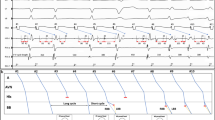Abstract
Macroreentrant circuit involving the bundle branches or the fascicles can develop bundle branch reentrant ventricular tachycardia (BBR-VT) in patients with conduction disturbance within the His-Purkinje system, which is associated with organic heart diseases and severe LV dysfunction. BBR-VT usually exhibits the QRS morphology with a left bundle branch block (LBBB) configuration or rarely a right bundle branch block (RBBB) pattern. In LBBB type BBR-VT, the right bundle branch (RB) constitutes the antegrade limb of reentrant circuit, and the retrograde limb is the left bundle branch (LB).
Diagnostic features suggestive of BBR-VTD are as follows: (1) Induction of BBR-VT during ventricular stimulation depends on His-Purkinje conduction delay. (2) The onset of the ventricular depolarization is preceded by the His potentials. (3) The H-V, RB-V, or LB-V interval during the tachycardia is longer than or equal to each interval during sinus rhythm. (4) Variations in the H-H, RB-RB, or LB-LB interval during the tachycardia precede the changes in the V-V interval. (5) The QRS morphology during atrial entrainment is identical to the QRS morphology during BBR-VT. (6) The difference between the postpacing interval after entrainment from the right ventricular apex and the tachycardia cycle length is less than 30 ms.
Catheter ablation of the RB is recommended and an effective therapy for treatment for BBR-VT. However, the prognosis is often poor in patients followed after successful ablation of BBR-VT because they have underlying structural heart disease and severe LV dysfunction. Therefore, ICD or CRT-D should be considered for the prevention of sudden cardiac death in these patients.
Similar content being viewed by others
References
Akhtar M, Gilbert C, Wolf FG, et al. Reentry within the His-Purkinje system. Elucidation of reentrant circuit using right bundle branch and His bundle recordings. Circulation. 1978;58:295–304.
Caceres J, Jazayeri M, McKinnie J, et al. Sustained bundle branch reentry as a mechanism of clinical tachycardia. Circulation. 1989;79:256–70.
Blanck Z, Dhala A, Deshpande S, et al. Bundle branch reentrant ventricular tachycardia: cumulative experience in 48 patients. J Cardiovasc Electrophysiol. 1993;4:253–62.
Mizusawa Y, Sakurada H, Nishizaki M, et al. Characteristics of bundle branch reentrant ventricular tachycardia with a right bundle branch block configuration: feasibility of atrial pacing. Europace. 2009;11:1208–13.
Crijns HJ, Smeets JL, Rodriguez LM, et al. Cure of interfascicular reentrant ventricular tachycardia by ablation of the anterior fascicle of the left bundle branch. J Cardiovasc Electrophysiol. 1995;6:486–92.
Delacretaz E, Stevenson WG, Ellison KE, et al. Map** and radiofrequency catheter ablation of the three types of sustained monomorphic ventricular tachycardia in nonischemic heart disease. J Cardiovasc Electrophysiol. 2000;11:11–7.
Lopera G, Stevenson WG, Soejima K, et al. Identification and ablation of three types of ventricular tachycardia involving the his-purkinje system in patients with heart disease. J Cardiovasc Electrophysiol. 2004;15:52–8.
Merino JL, Peinado R, Fernández-Lozano I, et al. Transient entrainment of bundle-branch reentry by atrial and ventricular stimulation: elucidation of the tachycardia mechanism through analysis of the surface ECG. Circulation. 1999;100:1784–90.
Merino JL, Peinado R, Fernandez-Lozano I, et al. Bundle-branch reentry and the postpacing interval after entrainment by right ventricular apex stimulation: a new approach to elucidate the mechanism of wide-QRS-complex tachycardia with atrioventricular dissociation. Circulation. 2001;103:1102–8.
Nakamura T, Nishizaki M, Shimizu M, et al. Conversion from irregular to regular wide QRS tachycardia: What is the mechanism? J Cardiovasc Electrophysiol. 2014;25:553–5.
Tchou P, Jazayeri M, Denker S, et al. Transcatheter electrical ablation of right bundle branch. A method of treating macroreentrant ventricular tachycardia attributed to bundle branch reentry. Circulation. 1988;78:246–57.
Cohen TJ, Chien WW, Lurie KG, et al. Radiofrequency catheter ablation for treatment of bundle branch reentrant ventricular tachycardia: results and long-term follow-up. J Am Coll Cardiol. 1991;18:1767–73.
Blanck Z, Akhtar M. Ventricular tachycardia due to sustained bundle branch reentry: diagnostic and therapeutic considerations. Clin Cardiol. 1993;16:619–22.
European Heart Rhythm Association, Heart Rhythm Society, Zipes DP, et al. ACC/AHA/ESC 2006 guidelines for management of patients with ventricular arrhythmias and the prevention of sudden cardiac death: a report of the American College of Cardiology/American Heart Association Task Force and the European Society of Cardiology Committee for Practice Guidelines (Writing Committee to Develop Guidelines for Management of Patients With Ventricular Arrhythmias and the Prevention of Sudden Cardiac Death). J Am Coll Cardiol. 2006;48:e247–346.
Blanck Z, Deshpande S, Jazayeri MR, et al. Catheter ablation of the left bundle branch for the treatment of sustained bundle branch reentrant ventricular tachycardia. J Cardiovasc Electrophysiol. 1995;6:40–3.
Mehdirad AA, Keim S, Rist K, et al. Long-term clinical outcome of right bundle branch radiofrequency catheter ablation for treatment of bundle branch reentrant ventricular tachycardia. Pacing Clin Electrophysiol. 1995;18:2135.
Epstein AE, DiMarco JP, Ellenbogen KA, et al. ACC/AHA/HRS 2008 guidelines for device-based therapy of cardiac rhythm abnormalities: a report of the American College of Cardiology/American Heart Association Task Force on Practice Guidelines (writing committee to revise the ACC/AHA/NASPE 2002 guideline update for implantation of cardiac pacemakers and antiarrhythmia devices): developed in collaboration with the American Association for Thoracic Surgery and Society of Thoracic Surgeons. Circulation. 2008;117:e350–408.
Author information
Authors and Affiliations
Corresponding author
Editor information
Editors and Affiliations
Rights and permissions
Copyright information
© 2018 Springer Nature Singapore Pte Ltd.
About this chapter
Cite this chapter
Nishizaki, M., Fukamizu, S., Sakurada, H. (2018). Bundle Branch Reentrant Ventricular Tachycardia. In: Hirao, K. (eds) Catheter Ablation. Springer, Singapore. https://doi.org/10.1007/978-981-10-4463-2_33
Download citation
DOI: https://doi.org/10.1007/978-981-10-4463-2_33
Published:
Publisher Name: Springer, Singapore
Print ISBN: 978-981-10-4462-5
Online ISBN: 978-981-10-4463-2
eBook Packages: MedicineMedicine (R0)




